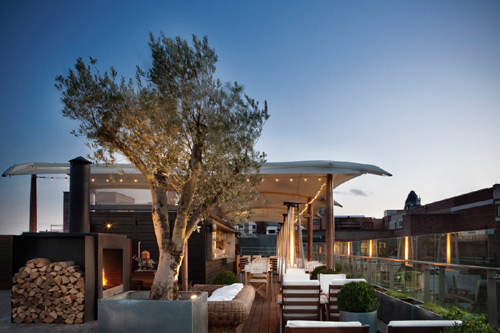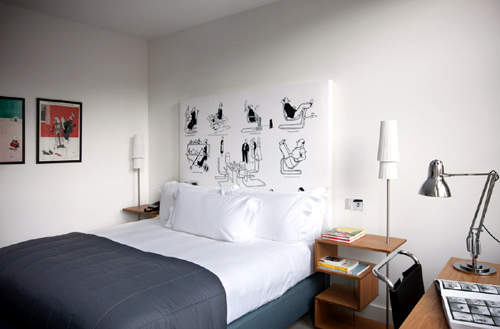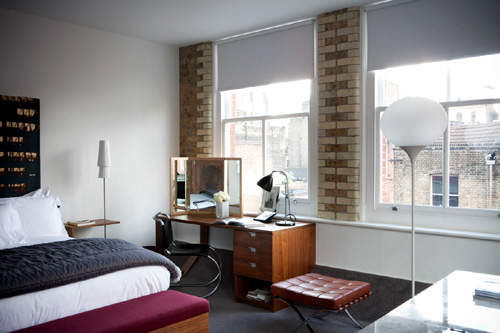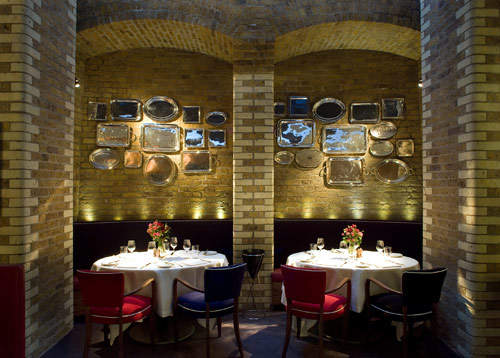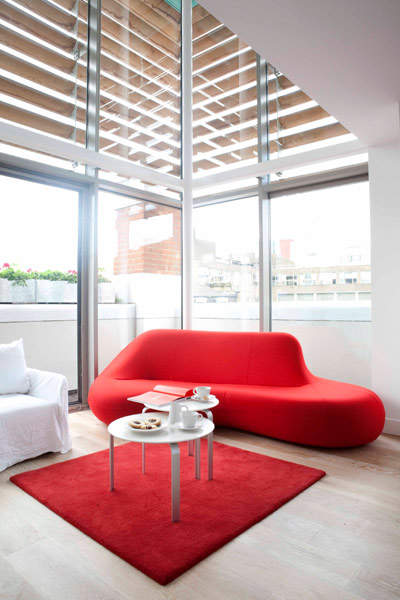Boundary, a new hotel and hospitality project in Shoreditch, East London, opened in January 2009. Located in a converted Victorian warehouse, Boundary offers three restaurants and bars, 17 guest bedrooms, a bakery and a small food store.
Boundary is a joint venture between Terence Conran, Vicki Conran and Peter Prescott.
Boundary rooms and suites
On the first and second floors there are 12 spacious guest bedrooms. The smallest of the rooms is 31m² (others are considerably larger) and the four corner rooms benefit from six large sash windows. Each of the rooms has a different design that has been inspired by legendary designers or design movements that the owners admire. They are:
- Le Corbusier and Charlotte Perriand
- Mies van der Rohe
- Andrée Putman
- Eileen Gray
- Bauhaus
- Heath Robinson
- Josef Hoffman
- Charles and Ray Eames
- Shaker
- Young British designers
- Conran
- Scandinavian
On the third and fourth floors there are four duplex suites designed by Sir Terence Conran, Lady Conran, Priscilla Carluccio and Polly Dickens – creative director of the Conran Shop. A further double-width suite has been designed by Sir David Tang. All of the suites have outside terraces.
Boundary restaurant and bar
Cooking is by Ian Wood, formerly of Almeida. Menus are based on classic French and English recipes, with a large selection of crustacea. Many of the dishes are perfectly simple; this applies to both the flavour and the preparation. The bar, also open to non-diners, promotes classic Savoy-esque cocktails, including an exceptionally stiff dry martini.
Albion café
Albion is located on the ground floor with large doors opening on to Boundary Street where pavement seating is provided. Its menu is based on typical British café food: nothing challenging or complicated, just straightforward hearty ingredients and recipes. A small food store specialising in British produce and a bakery offering an extensive range of breads and cakes complete the ground floor.
Boundary rooftop bar, restaurant and garden
Bondary Rooftop includes a large bar with seating arranged around an open fireplace, a 48-seat grill restaurant and a garden. There are 360° views, from Canary Wharf to the city’s Gherkin and Barbican, to the rooftops and spires of East London.
History of the Boundary
The original building has housed, among other things, a print works, a general warehouse and an advertising agency before lying vacant for several years. Over the course of a two-year period the layout of the original building has been altered to incorporate two new floors and a rooftop garden. Care has been taken to retain the most charming of the building’s original features: the distinctive brickwork, the large sash windows and industrial design light-wells.
Art and design led by Terence Conran
The design has been led by Terence Conran together with Conran & Partners, Terence’s architecture and interior design practice. A large amount of the art is being provided on loan from Terence Conran.
Green technology
From the outset the directors wanted to create an environmentally friendly building. This mantra has applied to all elements of the project, from selecting the materials to the use of local suppliers and insulating a 120-year-old building in a modern way. However, the main and most important element in this regard is the building’s bore holes.
Working with the Environment Agency, two 120m bore holes have been drilled below the floor in the restaurant. One hole collects water and energy from the London aquifer and the other hole returns the same untainted resource after it has been used to operate the air-conditioning, refrigeration systems, ice-machines and various other equipment.


